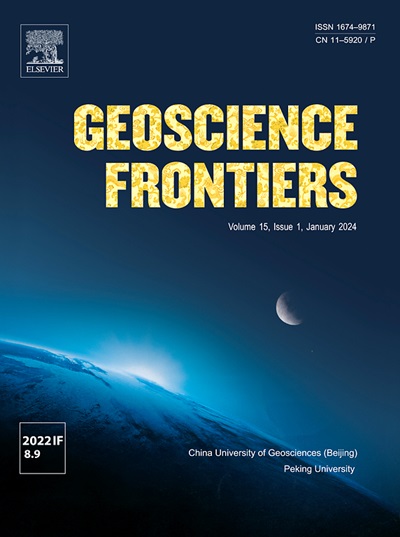An unusual lunar origin and chondritic refractory Antarctic micrometeorites
IF 8.5
1区 地球科学
Q1 GEOSCIENCES, MULTIDISCIPLINARY
引用次数: 0
Abstract
We report unearthing the first silicate-type (S-type) lunar Antarctic micrometeorites (AMM) spherule and another spherule with a refractory chondritic phase. The lunar spherule is made of Augite with minor Ni magnetite (<1 wt.%), in contrast to other known cosmic spherules. The Augite’s minor oxide range in the spherule are as follows: Wo37-41En25-27Fs34-36, Al2O3: 0.7–1 wt.%, Cr2O3: 0.01–0.06 wt.%, MnO: 0.32–0.39 wt.% and TiO2: 0.03–0.09 wt.%. The lunar spherule’s chemical characteristics indicate that it originated from very low Ti lunar basalt (VLT) mare basalts. Chondritic diopside (Wo46-47En50-47Fs5-6, Al2O3: 1.7–1.6 wt.%, Cr2O3: 0.6–0.63 wt.%, MnO: 0.2–0.4 wt.%, and TiO2: 0.0–0.02 wt.%) makes up the refractory phase in the second spherule. The chemical composition of diopside is indistinct from those of calcium aluminium inclusion (CAIs) found in both ordinary and carbonaceous chondrites. Our finding reveals that micron-sized lunar impact debris can potentially reach the Earth’s surface, similar to the earliest formed nebulae solid component.
一种不寻常的月球起源和球粒状难熔南极微陨石
我们报道发现了第一个硅酸盐型(s型)月球南极微陨石(AMM)球粒和另一个难熔球粒相球粒。月球球粒是由奥辉石和少量的镍磁铁矿(<1 wt.%)组成的,与其他已知的宇宙球粒不同。奥格特在球团中的微量氧化物范围为:Wo37-41En25-27Fs34-36, Al2O3: 0.7-1 wt.%, Cr2O3: 0.01-0.06 wt.%, MnO: 0.32-0.39 wt.%, TiO2: 0.03-0.09 wt.%。该月球粒的化学特征表明它起源于极低钛月玄武岩(VLT)海玄武岩。球粒透辉石(Wo46-47En50-47Fs5-6, Al2O3: 1.7-1.6 wt.%, Cr2O3: 0.6-0.63 wt.%, MnO: 0.2-0.4 wt.%, TiO2: 0.0-0.02 wt.%)构成第二球粒的耐火相。透辉石的化学成分与在普通球粒陨石和碳质球粒陨石中发现的钙铝包裹体(CAIs)的化学成分不明显。我们的发现表明,微米大小的月球撞击碎片可能会到达地球表面,类似于最早形成的星云固体成分。
本文章由计算机程序翻译,如有差异,请以英文原文为准。
求助全文
约1分钟内获得全文
求助全文
来源期刊

Geoscience frontiers
Earth and Planetary Sciences-General Earth and Planetary Sciences
CiteScore
17.80
自引率
3.40%
发文量
147
审稿时长
35 days
期刊介绍:
Geoscience Frontiers (GSF) is the Journal of China University of Geosciences (Beijing) and Peking University. It publishes peer-reviewed research articles and reviews in interdisciplinary fields of Earth and Planetary Sciences. GSF covers various research areas including petrology and geochemistry, lithospheric architecture and mantle dynamics, global tectonics, economic geology and fuel exploration, geophysics, stratigraphy and paleontology, environmental and engineering geology, astrogeology, and the nexus of resources-energy-emissions-climate under Sustainable Development Goals. The journal aims to bridge innovative, provocative, and challenging concepts and models in these fields, providing insights on correlations and evolution.
 求助内容:
求助内容: 应助结果提醒方式:
应助结果提醒方式:


